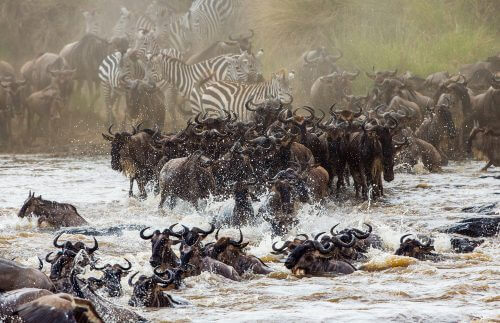A new study shows how due to human activity such as grazing and agriculture, the construction of fences and settlements around the "core" there is a huge pressure on the resources of the natural environment, on the animals and plants in it

In the coming months, thousands of nature lovers will travel and visit the nature reserves in Kenya and Tanzania, with the reserves that receive the most visitors being the Masai Mara in Kenya and the Serengeti in Tanzania.
The two reserves form part of an area of approximately sixty thousand square kilometers that is under varying conservation levels and contains settlements, agricultural areas and pastures. In the last forty years, surveys and studies have been conducted which show the impact of man on the reserves and the surrounding areas.
The Masai Mara reserve is a northern extension of the Serengeti and together they cover a huge area with a huge variety of animals and plants. In this area, the seasonal migration of about two million animals takes place, most of them wildebeest and they are joined by zebras and various deer, a combination that is a center of attraction for tourists from all over the world.
The researchers define the reserves as "the core of the protected area" and around them twelve conservation areas where communities of shepherds and farmers live.
Despite the definition of the areas as conservation areas, the entire area is in danger. A new study published in the journal Science Shows how due to human activity such as grazing and agriculture, the establishment of fences and settlements around the "core" creates enormous pressure on the resources of the natural environment, on its animals and plants.
This is the first time that a large team of scientists from different countries have combined a series of data collected over forty years, such as soil and vegetation monitoring, aerial photographs, animal tracking using GPS, and more to assess the human impact on the two reserves.
It was found that human activity caused extreme changes to habitats. It reduced the amount of grass, fencing agricultural areas caused the fragmentation of habitats which prevents animals from moving to find food and reproduce.
Key ecological functions are damaged and changed: because there are fewer natural fires, there is a takeover of bushes and trees that damage the quality of the soil and thus the vegetation cover decreases and the area becomes sensitive and vulnerable to climate change.
The researchers scanned more than sixty aerial photographs taken between 1977 and 2016 and made it possible to check the changes in animals in the bar, domesticated animals and settlements around the area. The human population figures were taken from the governments. It was found that within a radius of 60 km from the reserves, the human population increased by 26%, from 4.6 million to 5.8 million people within 13 years.
With more people comes more domesticated animals, settlements and fences. The number of fenced agricultural plots outside the "core" increased by more than 20%.
In the Mera region of Kenya, the density of settlements (bomas) increases up to three settlements per square meter every year.
In the Narok region of Kenya, the number of sheep and goats increased by about 270%, and in contrast, there was a small decrease of about 10% in the number of cows. The herds do not stay outside the boundaries of the reserves but invade the contents. You can see the pasture paths that penetrate into the reserves. This intrusion damages the quality and quantity of food for the animals in the wild.
In Masai Mara it was found that between the years 1977 and 2016 the penetration of cattle herds increased by more than 1000% and the penetration of sheep and goat herds increased even more. At the same time, the number of permanent wild animals in the reserve decreased by 87% to 40%, at the same time the number of migrants, mainly wildebeest, decreased by 63%.
In 34 years agricultural farms grew and today the farms cover 54% of the areas around the reserves. The farms cause the destruction of the habitats in their surroundings, the combination of agricultural farms and the density of sheep and cattle increases the pressure on the shepherds to invade the reserves.
The biggest damage was observed among the migratory ones - such as the wildebeest. Data collected from tracking devices on wildebeest show that the herds come densely to fixed areas, which reduces the amount of food for each individual, because overgrazing by cattle damages the quality of the soil, so less pasture is available to the wildebeest.
When domesticated animals "clear" the grass there are fewer natural fires, which allows young trees to grow. This is how pastures become sparse woodlands.
The herbivores like the wildebeest are replaced by leaf eaters like the giraffe.
The decrease in the number of animals in the bar in Masai Mara is worrying because the migratory herds come to this area in the dry season. Because of the huge increase in the number of sheep and cattle, all kinds of large animals are disappearing from the area.
The meaning of the extreme changes is that the future of the Serengeti-Mara is uncertain, therefore the researchers call for an immediate response, an urgent action that will ensure the future of the area and its wild animals.
It is important to protect the migration corridors along the boundaries of the reserve, it is important to regulate and regulate the activities of coal traders, farmers, shepherds and fence sitters.
Criminal hunters and herders who invade reserves must be punished to prevent them from harming the reserves.
Both reserves are considered one of the wonders of the world and as such attract many tourists. A correct distribution of the income from tourism will facilitate the correct implementation of the conservation activity.

One response
Crying for generations!